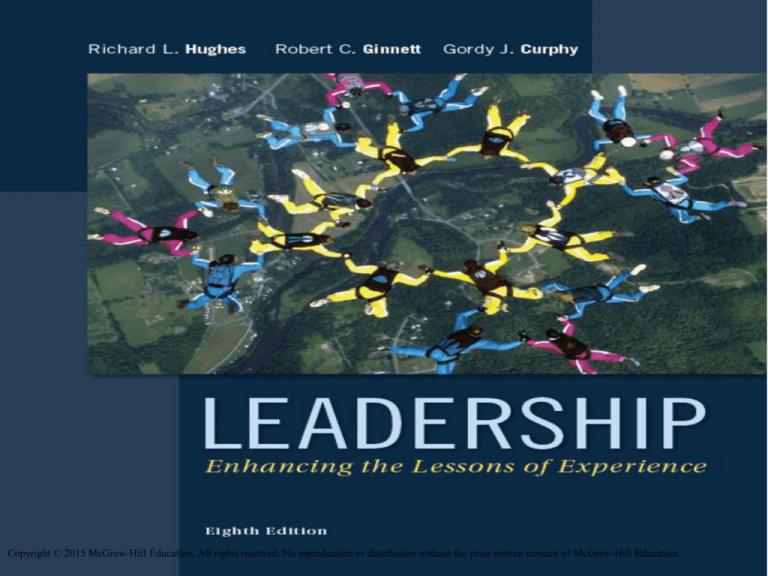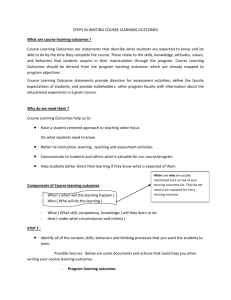
Copyright © 2015 McGraw-Hill Education. All rights reserved. No reproduction or distribution without the prior written consent of McGraw-Hill Education.
7-1
Chapter
7
Leadership Behavior
“The truth of the matter is that you always know
the right thing to do. The hard part is doing it.”
Norman Schwartzkopf,
U.S. Army
7-2
Introduction
• Differentiating between effective and ineffective
leaders requires looking at their behaviors and
results.
• Leadership behavior can be observed and
measured.
• Personality traits, values, and intelligence
cannot be directly observed, but they may
contribute to effective leadership behaviors.
• Two other factors that influence leadership
behavior are the followers and the situation.
– Follower and situational factors can help determine
whether a particular leadership behavior is “bad” or
“good.”
7-3
Why Study Leadership Behavior?
• Many people in positions of authority either
cannot build and motivate teams or do not
realize the negative impact of their behavior.
• Leadership behaviors are a function of
intelligence, personality traits, emotional
intelligence values, attitudes, interests,
knowledge, and experience.
• Over time, leaders learn and discern the most
appropriate and effective behaviors.
• Individual differences, followers, and situational
variables play a pivotal role in a leader’s
actions.
7-4
The Building Blocks of Skills
FIGURE 7.1
The Building Blocks of Skills
7-5
The Early Studies
• Ohio State University developed the Leader
Behavior Description Questionnaire (LBDQ).
and identified two independent dimensions of
behaviors.
– Consideration is how friendly and supportive a
leader is toward subordinates. Leaders high in
consideration show concern by speaking up for
subordinates’ interests and expressing appreciation
for their work.
– Initiating structure is how much a leader
emphasizes meeting work goals and accomplishing
tasks. Leaders high in initiating structure engage in
task-related behaviors like assigning deadlines and
monitoring performance levels.
– These dimensions are independent continuums.
7-6
The Early Studies (continued)
• University of Michigan identified four categories
of leadership behaviors that are related to
effective group performance.
– Goal emphasis and work facilitation are jobcentered dimensions similar to the LBDQ initiating
structure behaviors.
– Leader support and interaction facilitation are
employee-centered dimensions similar to the LBDQ
consideration dimensions.
– Job-centered and employee-centered behaviors are
at opposite ends of a single continuum.
• Findings of both university studies suggest that
no universal set of leader behaviors is always
associated with leadership success.
7-7
The Leadership Grid
• Alternative conceptualizations focus on:
– Identifying key leadership behaviors.
– Determining if these behaviors have positive
relationships with leadership success.
– Developing behaviors related to leadership success.
• The Leadership Grid profiles leader behavior
on two dimensions: concern for people and
concern for production.
– “Concern” reflects how a leader’s underlying
assumptions about people at work and the importance
of the bottom line affect leadership style.
• The most effective leaders are said to have high
concern for both people and for production.
7-8
The Leadership Grid
FIGURE 7.2
The Leadership Grid
Source: Robert R. Blake and Anne Adams McCanse, Leadership Dilemmas—Grid Solutions (Houston: Gulf
Publishing, 1991), p. 29. Copyright 1991. Reprinted with permission of Grid International
7-9
Competency Models
• Competency models describe the behaviors
and skills needed for organizational success.
• All organizational competency models fall into
one of four major categories.
–
–
–
–
Intrapersonal skills: adapting to stress, setting goals
Interpersonal skills: communicating, interacting
Leadership skills: building effective teams
Business skills: thinking strategically
• The Hogan and Warrenfelz model:
– Allows people to see connections between models.
– Makes predictions about the ease or difficulty of
changing leadership behaviors and skills.
– Points out what behaviors leaders must exhibit to be
effective.
7-10
Leadership Competency Model
FIGURE 7.3
An example of a
leadership competency
model.
Source: G.J. Curphy, K.
Louiselle, and S. Bridges:
Talent Assessment
Overview: 360-Degree
Feedback Report. Eagan,
MN: Advantis Research &
Consulting, 2003.
7-11
The Leadership Pipeline
• The Leadership Pipeline model shows where
leaders should spend time, what behaviors they
need to exhibit, and what challenges are likely
at different organizational levels.
• It outlines leader development through
organizational levels from first-line supervisor to
functional manager to CEO.
• The pipeline offers a roadmap for individuals
who want to chart their career progression.
• It provides a useful framework for considering
how leadership competencies change as
people are promoted through organizations.
7-12
The Leadership Pipeline
Organizational Level
Individual
contributor
First-line
supervisor
Midlevel
manager
Competency Requirements
Technical proficiency. Using
company tools. Build
relationships with team
members.
Planning projects. Delegating
work.
Coaching and feedback.
Performance monitoring.
Select, train, and manage firstline supervisors. Manage
boundaries and deploy
resources to teams.
Time Applications
Meet personal due dates.
Arrive/depart on time.
Work Values
Get results through personal
proficiency.
High-quality work. Accept
company values.
Annual budget planning.
Make time available for
followers. Set priorities for
team.
Get results through
others. Success of followers.
Success of the team.
Monitor performance of
each team. Make time to coach
first-line supervisors.
Appreciate managerial
versus technical work.
Developing first-line
supervisors.
Excerpt from TABLE 7.2
The Leadership Pipeline
Source: R. Charan, S. Drotter, and J. Noel, The Leadership Pipeline: How to Build the Leadership-Powered
Company (San Francisco: Jossey-Bass, 2001).
7-13
Community Leadership
• Community leadership is the process of
building a team of volunteers to accomplish an
important community outcome.
• Community leaders lack position power and
also have fewer resources and rewards.
• Three competencies are needed to drive
community change efforts successfully:
– Framing: recognizing and defining opportunities
– Building social capital: developing and maintaining
relationships
– Mobilization: engaging a critical mass to take action
and achieve a specific outcome
7-14
The Components of Community
Leadership
FIGURE 7.4
The Components of Community Leadership
Source: J. Krile, G. Curphy, and D. Lund, The Community Leadership Handbook: Framing Ideas, Building
Relationships, and Mobilizing Resources (St. Paul, MN: Fieldstone Alliance, 2006).
7-15
Assessing Leadership Behaviors:
Multirater Feedback Instruments
• 360-degree, or multirater, feedback tools
allow managers to gather accurate information
from peers and direct reports about their on-thejob behaviors and leadership effectiveness.
• Questionnaire construction is very important.
• Leaders who received 360-degree feedback
had higher performing work units.
• 360-degree systems should tell leaders about
their own strengths and development needs
rather than make comparisons between people.
• 360-degree feedback provides insight into selfperceptions and others’ perceptions of
leadership skills.
7-16
Multirater Feedback Instruments
(continued)
• The key to high observer ratings is to develop a
broad set of leadership skills that help groups
accomplish goals.
• Research shows that it is possible to change
others’ perceptions of a leader’s skills over time.
– Leaders must set development goals and commit to a
development plan to improve skills.
• Societal or organizational culture, race, and
gender play key roles in the accuracy and utility
of the 360-degree feedback process.
• 360-degree feedback should be built around a
competency model.
7-17
Sources for 360-Degree Feedback
FIGURE 7.5
Sources for 360-Degree Feedback
7-18
Example of 360-Degree Feedback
FIGURE 7.6
Example of 360-Degree Feedback.
Source: K. Louiselle, G. J. Curphy, and S. Bridges, C3 360-Degree Feedback Report (Eagan, MN: Advantis
Research and Consulting, 2003). Reprinted with permission of Advantis Research and Consulting.
7-19
Summary
• Leaders can benefit from leadership behavior
research in several ways.
• Research has helped to identify factors that can
cause high-potential managers to fail.
• The Leadership Grid provides a taxonomy of
leader types based on behavioral orientation.
• The Leadership Pipeline model allows
organizations to chart leader progression by
using customized competency models.
• Community leadership facilitates the
accomplishment of community-oriented goals.
• 360-degree feedback gives leaders feedback
useful in improving their performance.
7-20








